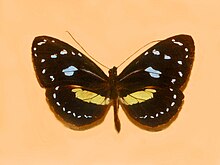Elzunia humboldt
| Elzunia humboldt | |
|---|---|

| |
| E. h. bomplandii from Colombia | |
| Scientific classification | |
| Kingdom: | |
| Phylum: | |
| Class: | |
| Order: | |
| Family: | |
| Genus: | |
| Species: | E. humboldt
|
| Binomial name | |
| Elzunia humboldt (Latreille, 1809)
| |
| Synonyms | |
| |
Elzunia humboldt is a species of butterfly of the family Nymphalidae, subfamily Danainae, tribus Ithomiini.
Description[edit]
Elzunia humboldt has a wingspan of about 80–85 millimetres (3.1–3.3 in). This species is quite variable depending on the subspecies. The uppersides of the wings are black, with a series of small white spots on the margins. At the base of the hindwings usually there is a broad yellow band, while in the middle of the forewings usually there are one or more white spots. The undersides of the wings have a similar pattern to the uppersides, but the basic colour is reddish instead of black and the hindwings usually have two series of white spots.
Distribution[edit]
This species can be found in Colombia, Ecuador and Peru.
Subspecies[edit]
- E. h. humboldt (Colombia)
- E. h. bonplandii (Guérin-Méneville, [1844]) (Colombia)
- E. h. cassandrina Srnka, 1884 (Ecuador)
- E. h. regalis (Stichel, 1903) (Colombia)
- E. h. albomaculata (Haensch, 1903) (Ecuador)
- E. h. joiceyi (Kaye, 1918) (Colombia)
- E. h. atahualpa Fox, 1956 (Peru)
- E. h. judsoni Fox, 1956 (Peru)
Etymology[edit]
The butterfly was named to honour the German explorer Alexander von Humboldt.
References[edit]
- "Elzunia humboldt (Latreille, 1809)" at BioLib.cz
- "Elzunia Bryk, 1937" at Markku Savela's Lepidoptera and Some Other Life Forms
- Butterflies of America
External links[edit]
